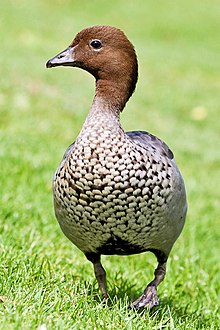Finsch's duck
| Finsch's duck | ||||||||||
|---|---|---|---|---|---|---|---|---|---|---|
| Systematics | ||||||||||
|
||||||||||
| Scientific name | ||||||||||
| Chenonetta finschi | ||||||||||
| ( Van Beneden , 1875) |

Finsch's duck ( Chenonetta finschi ) was a large, probably flightless duck bird that was only found in New Zealand . The species was originally assigned to the monotypic genus Euryanas . Today it is considered to be closely related to the maned goose and is assigned to the genus Chenonetta . The splitting off as an independent species was probably not that long ago. The common ancestors settled New Zealand about 230,000 years ago, when New Zealand was still largely unforested. It bears its name in honor of the German ornithologist Otto Finsch .
features
Finsch's duck was much larger than the maned goose and probably weighed twice as much as this species. It also had significantly longer legs. However, the wings were severely receded. Based on the fossil record, it can be concluded that the ancestors of this species lost 10 percent of their wing length within 10,000 years. This is almost certainly due to the lack of predatory mammals in New Zealand. At the time of its extinction, the species was believed to be completely flightless . The split from the maned goose is probably due to their more land-based way of life.
Since the mane goose is predominantly herbivorous and usually only ingests invertebrates with their vegetable diet by chance, it is assumed that Finsch's duck also ate predominantly vegetable food. The species probably nested in burrows.
Causes of extinction
It is assumed that Finsch's duck died out due to hunting by the Maori and hunting by rats. The Maori settled New Zealand around 1000 AD and certainly brought rats with them, which, as nest robbers, also led to a sharp decline in the populations of other flightless bird species. As with many other flightless and large birds, numerous fossil records have been found in Maori mussel piles. With the help of radiocarbon dating it was possible to prove that this species survived at least until the late 15th century and very likely until the middle of the 17th century. This species may still exist after Europeans settled New Zealand. There is a report that in 1870 dogs caught a large, flightless goose with reddish brown plumage near Opotiki .
supporting documents
Individual evidence
- ↑ Trevor H. Worthy & Storrs L. Olson (2002): Relationships, adaptations, and habits of the extinct duck 'Euryanas finschi' . Notornis 49 (1): 1-17. PDF full text
- ^ Tennyson and Martinson, p. 52
- ^ Tennyson and Martinson, p. 52
- ^ Tennyson and Martinson, p. 52
literature
- Tennyson, A. & Martinson, P. (2006) Extinct Birds of New Zealand , Te Papa Press, Wellington, ISBN 0-909010-21-8